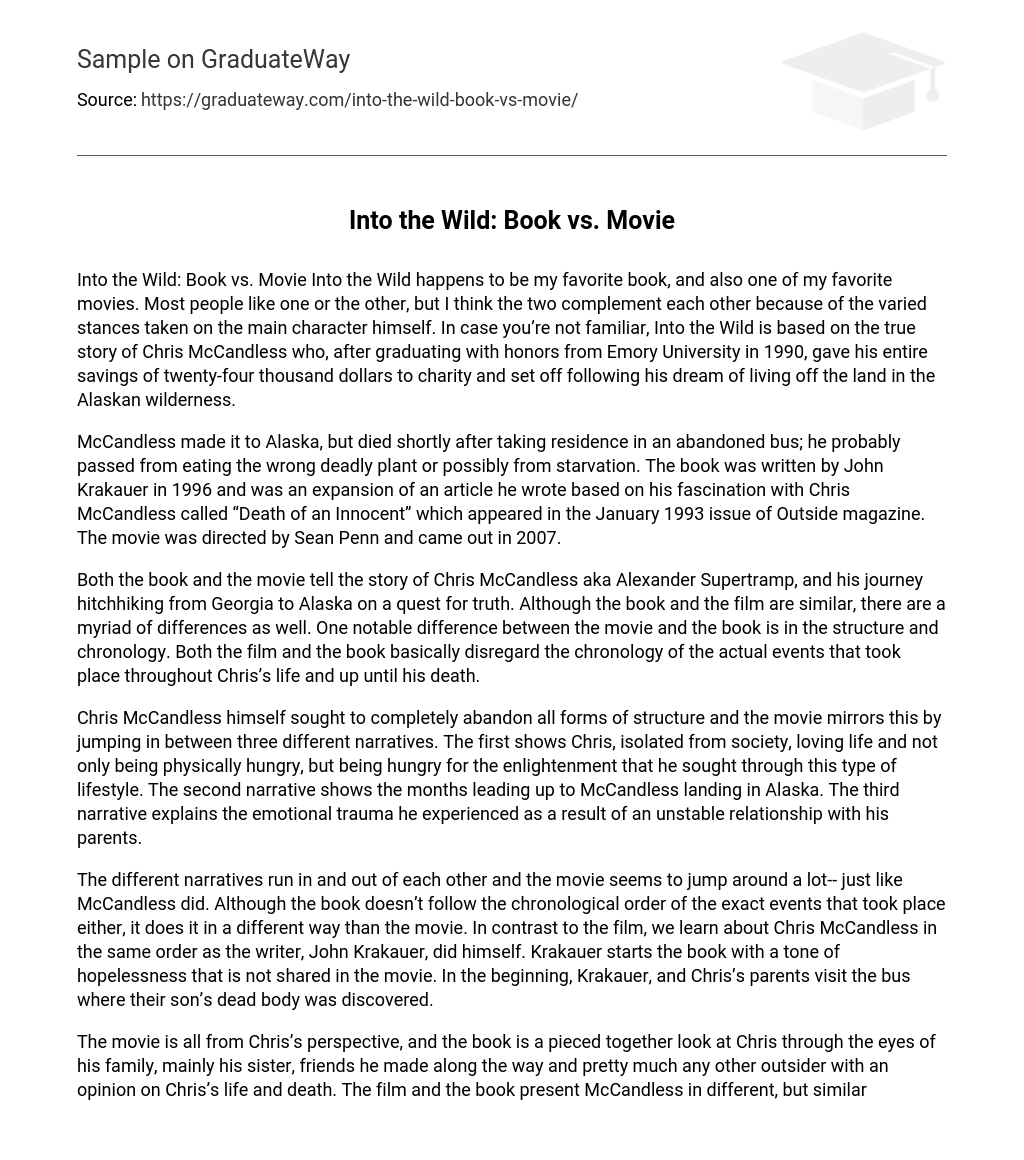Into the Wild happens to be my favorite book, and also one of my favorite movies. Most people like one or the other, but I think the two complement each other because of the varied stances taken on the main character himself. In case you’re not familiar, Into the Wild is based on the true story of Chris McCandless who, after graduating with honors from Emory University in 1990, gave his entire savings of twenty-four thousand dollars to charity and set off following his dream of living off the land in the Alaskan wilderness.
McCandless made it to Alaska, but died shortly after taking residence in an abandoned bus; he probably passed from eating the wrong deadly plant or possibly from starvation. The book was written by John Krakauer in 1996 and was an expansion of an article he wrote based on his fascination with Chris McCandless called “Death of an Innocent” which appeared in the January 1993 issue of Outside magazine. The movie was directed by Sean Penn and came out in 2007.
Both the book and the movie tell the story of Chris McCandless aka Alexander Supertramp, and his journey hitchhiking from Georgia to Alaska on a quest for truth. Although the book and the film are similar, there are a myriad of differences as well. One notable difference between the movie and the book is in the structure and chronology. Both the film and the book basically disregard the chronology of the actual events that took place throughout Chris’s life and up until his death.
Chris McCandless himself sought to completely abandon all forms of structure and the movie mirrors this by jumping in between three different narratives. The first shows Chris, isolated from society, loving life and not only being physically hungry, but being hungry for the enlightenment that he sought through this type of lifestyle. The second narrative shows the months leading up to McCandless landing in Alaska. The third narrative explains the emotional trauma he experienced as a result of an unstable relationship with his parents.
The different narratives run in and out of each other and the movie seems to jump around a lot– just like McCandless did. Although the book doesn’t follow the chronological order of the exact events that took place either, it does it in a different way than the movie. In contrast to the film, we learn about Chris McCandless in the same order as the writer, John Krakauer, did himself. Krakauer starts the book with a tone of hopelessness that is not shared in the movie. In the beginning, Krakauer, and Chris’s parents visit the bus where their son’s dead body was discovered.
The movie is all from Chris’s perspective, and the book is a pieced together look at Chris through the eyes of his family, mainly his sister, friends he made along the way and pretty much any other outsider with an opinion on Chris’s life and death. The film and the book present McCandless in different, but similar ways; some may say it’s the difference between fact and fiction. Both are obviously interpretations of Chris McCandless’s life and death, but I find the book to be more factual. Krakauer dug in deep, and got extensive interviews from the few people Chris considered to be his friends.
In fact, the majority of the first chapter in the book is based on the memory of Jim Gallien, the man who dropped Chris off at the head of the Stampede Trail in Alaska. The movie, on the other hand, starts with actor, Emile Hersh, who plays McCandless, reading Chris’s own words from personal journals. The book looks at Chris as more of a tragic psychological study and begs the question, “What could have been done differently? ” while the movie paints a more glorified, romantic view of it all, merging fact with fiction.
Krakauer doesn’t portray McCandless as crazy, not by a long shot, but as a loner with a set of idealistic values that eventually led to his death, alone, in the Alaskan wilderness. The book sticks to the facts, yet the movie fills in the gaps and answers the questions. In one scene from the film, when McCandless is dying, he’s shown thinking last thoughts of his parents, wondering if they still loved him. We obviously don’t know what was going through Chris’s mind at the actual time of death. These differences can be explained by the purpose of the book versus the purpose of the movie.
The purpose of Krakauer is to seek factual truth because it is a non-fiction book, while in the movie, spiritual truth is sought after, leaving some wiggle room for Sean Penn to bend the factual truth and omit certain details. In conclusion, the film isn’t exactly an accurate portrayal of the events that took place. It celebrates the life of Chris McCandless and the optimism he had upon setting off on his journey in a fairy tale sort of way. I believe the film is beautifully done, and, if I had ever only seen the movie nd never read the book, I would have sympathized more with Chris.
The book, on the other hand, confines McCandless to facts and structure and reads like a biography. Ironically, facts and structure weren’t really a part of McCandless’s vocabulary or philosophy. Both the book and the movie seek truth and attempt to find it in their own different ways. Even though the book and the movie have little in common, especially in terms of how Chris McCandless is portrayed, his story from either perspective has touched millions of lives and that is something in common.





